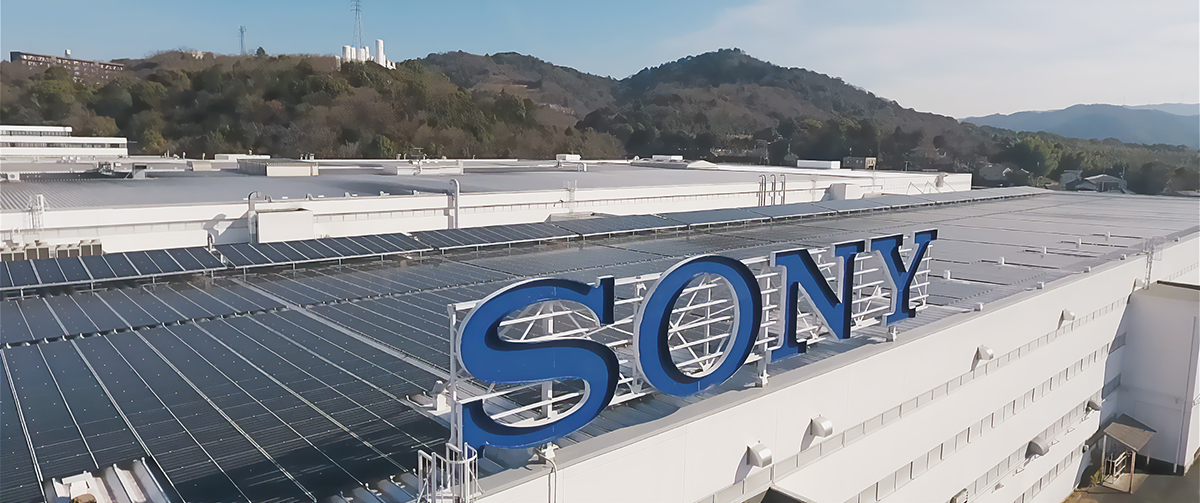November 11, 2022

The Sony Group is targeting a net-zero greenhouse gas (GHG) emissions throughout its value chain by 2040 and 100% renewable electricity in our operations by 2030. Sony Corporation (SEC) joins other group companies in pursuing these goals, and as Entertainment, Technology & Services (ET&S) segment, we are close to achieving 100% renewable electricity with just Japan/East Asia region and Pan Asia region remaining to complete the transition within fiscal year (FY) 2023.
ET&S sites in Europe region, North America region and China region have already completed the transition to renewable electricity sources.
In Europe region, the transition began in FY2002, and the sites that have obtained ISO 14001 certification have used 100% renewable electricity for all of their electricity needs since FY2008.
Sustainability is a high concern in Europe and the energy market has had renewable electricity options for people and companies for a long time. Not only as Sony Europe but also employees are highly conscious about environment as well. In Sony UK Technology Centre (UK TEC) based in Pencoed, United Kingdom, there are around 25 Environment, Health, and Safety (EHS) representatives on site, they meet regularly to discuss EHS issues and does training on a different topic. There are also separate group of energy representatives, who are responsible for energy usage/wastage in their departments.
UK TEC have around 900 solar panels on site which produces approximately 6% of their total electricity for the site. Last year it generated 207,802 kwh from the solar panels. UK TEC have recently had a grant approved to have further installations of solar panels, which will double the current usage to approximately 12% - this is an ongoing project.
 UK TEC solar panels
UK TEC solar panels
Sony office in Minatomirai, Yokohama have already introduced renewable electricity, and offices in Shinagawa and Osaki is expected to do so this fiscal year.
 Sony City Minatomirai
Sony City Minatomirai Sony City (Shinagawa)
Sony City (Shinagawa) Sony City Osaki
Sony City OsakiAs electricity consumption is higher at manufacturing sites than at offices, the former have adopted a variety of measures. Kohda-site of Sony Manufacturing & Operations Corporation has introduced on-site solar power generation as well as off-site solar power generation that utilizes intracompany electricity transfer.*1 Purchases of renewable electricity certificates*2 and other approaches are also under consideration. In addition, Kohda site will introduce renewable electricity under a virtual PPA, which is already a standard method of introducing renewable electricity in Europe and the United States and expect to utilize at a scale of approximately 2.4 million kWh per year.
 3,180 rooftop solar panels are installed at the Kohda Site. Further installations of the solar panels are planned to provide approximately 10% of the manufacturing site's electricity needs.
3,180 rooftop solar panels are installed at the Kohda Site. Further installations of the solar panels are planned to provide approximately 10% of the manufacturing site's electricity needs.The nascent renewable electricity market remains challenging in some areas in Pan Asia region. But as shown by installing solar panels with a capacity of nearly 2.7 million kWh, equivalent to reducing CO2 emissions by about 1,300 tons annually, at Sony Technology (Thailand), we are taking a variety of steps in pursuit of 100% renewable electricity.
 Solar panels at Sony Technology (Thailand) Co., Ltd.
Solar panels at Sony Technology (Thailand) Co., Ltd. Solar panels at Sony EMCS (Malaysia) Sdn. Bhd.
Solar panels at Sony EMCS (Malaysia) Sdn. Bhd.